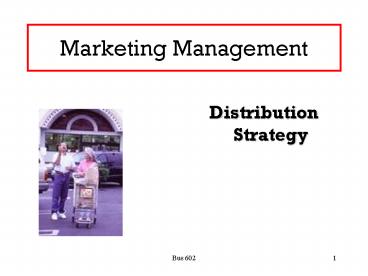Marketing Management - PowerPoint PPT Presentation
1 / 30
Title:
Marketing Management
Description:
Create greater efficiencies/Economies of scale ... Foot Locker, Northern. Traditions) Bus 602. 26. Retailer Marketing Decisions. Retailer ... – PowerPoint PPT presentation
Number of Views:41
Avg rating:3.0/5.0
Title: Marketing Management
1
Marketing Management
- Distribution Strategy
2
Final Exam
- Date Thursday August 12th, 2004
- Time 700 AM - 1000 PM
- Location TBC
- Conflicts?
- Come see me separately or contact the MBA office
3
Why Use Mktg Intermediaries?
- Create greater efficiencies/Economies of scale
- Transform producers narrow product assortment
into broad assortment wanted by consumers - Match supply with demand
- Whether it is products or services Mktg
Intermediaries help bring them to market
4
Distribution Channel Functions
- Information
- Promotion
- Contact
- Matching offer
- Negotiation
- Physical distribution
- Financing
- Risk taking
5
Number of Channel Levels
- Channel Level
- A layer of intermediaries that performs some work
in bringing the product and its ownership closer
to the final buyer - Producer and Final Consumer in every channel
- Flows between channel levels
- Physical
- Ownership
- Payment
- Information
- Promotion
6
Number of Channel Levels
- Direct Marketing Channel
- Company sells directly to consumers and has NO
intermediaries - Indirect Marketing Channels
- Company sells through one or more intermediaries
- More levels increase customer contacts
- Fewer levels - more control and less complex
7
Conventional Channels of Distribution of Consumer
Goods
8
Conventional Channels of Distribution of
Organizational Goods
9
Channel Behaviour
- Channels are complex behavioural systems
- Channels should be managed so they deliver on the
needs and wants of the end consumer - Interaction between people and companies to
achieve their own goals - All members interdependent
- Each member a specialist
- Conflict is inevitable
- Horizontal and vertical
- Good conflict resolution can occur as each
members role and goals are clearly defined
10
Conventional vs. Vertical Marketing
11
Marketing SystemsVertical and Horizontal
Vertical Marketing
Horizontal Marketing
Systems
Systems
Corporate VMS
Contractual VMS
Wholesaler-sponsored
voluntary chains
Retailer cooperative
Franchise organizations
Administered VMS
12
Hybrid Marketing Channel
13
Changing Channel Organization
- Disintermediation
- Bypassing and going direct
- Radical new channels
- Traditional intermediaries dropping by wayside
- Need to add value
- Causes channel conflict
14
Channel Design Decisions
- Analyzing consumer characteristics/service needs
- Analyzing product characteristics
- Intermediary characteristics
- Competitor characteristics
- Company characteristics
- Environmental characteristics
- Also
- Distribution coverage required
- Degree of control desired
- Total distribution costs
- Channel flexibility
15
Channel ManagementSelecting Channel Members
- What makes the best?
- Years in business
- Other lines carried
- Growth and profit record
- Cooperation and reputation
- Potential for long-term relationship
- Sales force size and quality
- Retail customers, location, and growth potential
16
Channel ManagementMotivating Channel Members
- First sell intermediaries
- Why is your product the best so they can go out
an sell it accordingly - Use positive motivation
- Incentives if they sell effectively
- May use negative motivation
- Threatening not a common practice
- Long-term partnerships
- Are the key to managing the business and keeping
informed
17
Channel ManagementEvaluating Channel Members
- Measure Performance Against Standards
- Sales quotas, Average inventory levels, Customer
delivery time, Treatment of damaged or lost
goods, Cooperation on promotion and training,
Customer service levels - Recognize and reward performers
- Motivate the ones you can
- Help the ones in trouble
- Replace those with issues
18
Nature and Importance of Physical Distribution
and Mktg Logistics
- Planning, implementing, and controlling the flow
from origin to consumption meeting customer
requirements at a profit - Right product, right customer, right place, right
time - Market logistics thinking
- Manage supply and demand chains
- Logistics System Goals
- Provide targeted level of service at least cost
- Research customer importance of services
- Set service levels for each segment
- Profit objective over sales (?? Is this really
true??)
19
Major Logistics Functions
- Order processing
- Warehousing
- Storage warehouses, distribution centres,
automated warehouses - Inventory management
- When and how much?
- Just-in-time (JIT)
- Transportation of goods
- Anything I have missed???
20
Integrated Logistics Management
- Cross-functional teamwork inside the company
- Build channel partnerships
- Cross-functional, cross-company teams
- Shared projects
- Information sharing
- Continuous inventory replenishment systems
- Response-based distribution systems
21
Integrated Logistics Management
- Third party logistics
- Often do it more efficiently and at lower cost
- Frees company to focus on core business
- Increasingly complex environment
22
Retailing
- All activities involved in selling goods or
services directly to final consumers for their
personal, non-business use - Most via retail stores
- Non-store continuing to grow
23
Store Retailing Classifications
24
Store Retailing Classifications Retail
Organizations
25
Store Retailing Classifications Retail
Organizations
26
Retailer Marketing Decisions
27
The Future of Retailing
- New retail forms and shortening retail life
cycles - Wheel of retailing
- Growth of non-store retailing
- Canadian retailers slow to e-tail
- Not a threat, Lack of senior commitment, Order
fulfillment challenge, Lack of resources,
Measuring performance - Increasing intertype competition
- Rise of mega-retailers
- Growing importance of retail technology
- Retail stores as communities centrals, return
to more personal interaction
28
Wholesaling
- All activities involved in selling goods and
services to those buying for resale or business
use - Better at performing one of the channel functions
29
Wholesaler Marketing Decisions
30
Trends in Wholesaling
- Fierce resistance to price increases
- Improve services and reduce costs
- Competition
- Consolidation
- More services
- Blurred distinction between large and small































